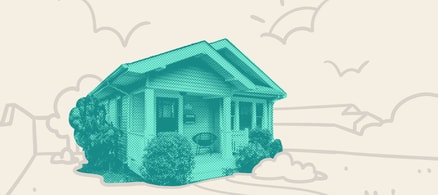Federal first-time homebuyer programs
Stop overpaying for home insurance
Home insurance is an essential expense – one that can often be pricey. You can lower your monthly recurring expenses by finding a more economical alternative for home insurance.
SmartFinancial can help you do just that. SmartFinancial’s online marketplace of vetted home insurance providers allows you to quickly shop around for rates from the country’s top insurance companies, and ensure you’re paying the lowest price possible for your home insurance.
Explore better ratesFederal Housing Administration (FHA) loans
The FHA is a division of the Department of Housing and Urban Development (HUD). Congress established the FHA in 1934 to help more Americans — including first-time homebuyers — get a mortgage, especially those who would otherwise have trouble qualifying.
At the time, only about 40% of Americans were homeowners. The country was still in the middle of the Great Depression and mortgage terms were notoriously difficult. Borrowers were limited to just 50% of the home’s market value and the repayment schedule was three to five years, with a big balloon payment at the end.
FHA loans are way more lenient than conventional loans, even today. They are insured by the government, which means if you fail to make your mortgage payments, the FHA will step in to financially support your lender.
Because they’re protected, lenders are more willing to take on risky loan applicants. You won’t need a pristine credit record or a huge down payment to qualify for an FHA loan.
How do FHA loans work?
With an FHA loan, how much you have available for your down payment will impact your credit score requirement. The minimum down payment first-time homebuyers can make with an FHA loan is 3.5% of the home’s overall purchase price, and lenders will want to see a score of at least 580.
But if you’re able to put down 10% on your home, you could be approved with a score as low as 500.
The trade-off with an FHA loan is that, in order to fund its guarantee to lenders, the FHA will ask you to pay a mortgage insurance premium (MIP), which is actually composed of two fees:
-
Upfront: This one-time premium is typically equal to 1.75% of the purchase price and is paid when you receive the loan. Alternatively, it can be folded into what you owe on your loan.
-
Monthly: This fee is collected in regular installments and added to your mortgage. It usually ranges from 0.45% to 1.05% of the total loan amount, depending on how much you’ve borrowed and whether you have a 15-year or 30-year term.
When you put down less than 10% of your loan, you’ll pay mortgage insurance for the entire life of your loan — unless you refinance with a different loan type at some point. Even if you put down 10% or more, you’ll still have to pay MIP for the first 11 years of your mortgage.
So while you don’t need to have access to as much money upfront for these loans, over the life of your loan, MIP will add to the overall cost of your mortgage.
Another factor in how much your monthly payments will end up costing you is your interest rate. Your loan will either have a fixed or adjustable interest rate:
- With fixed-rate loans, your interest rate will stay the same throughout your entire term.
- And with an adjustable rate mortgage (also known as an ARM), the interest will move along with a benchmark index rate, like Libor. ARMs often have lower rates to start, but they can increase over time.
As another method to protect itself (in case you ever can’t make your payments), the FHA will also limit how much you can borrow. Your maximum purchase price will depend on where you live.
In 2022, the maximum FHA loan for a single-family home in a low-cost county is $420,680 But for buyers in more expensive housing markets, that number could go up to $970,800. The HUD offers a search engine to help you find your region’s limit.
On the bright side, the FHA also limits lenders on the amount they can charge you in closing costs and allows the seller, builder and/or lender to voluntarily cover your closing costs — at least, up to 6% of the home’s value.
Types of FHA loans
There are a few types of FHA loans designed to meet the needs of different borrowers, including first-time homebuyers:
FHA 203(k)
This is a great loan to use when the home you’re buying is going to need some upgrades or renovations. There are two different types: limited and standard.
-
Limited 203(k): These involve a little less paperwork, and the application process for repairs or improvements tends to be a little easier. But you’re limited in the amount you can take out, as the Limited 203(k) caps at $35,000. And you’ll have to be able to live in your new home while you renovate it.
-
Standard 203(k): There’s more paperwork involved with the Standard plan, but you can apply this loan to any improvements that cost more than $5,000. You’ll also be able to add up to six months of mortgage payments so you can live elsewhere while your home is under construction.
Energy Efficient Mortgage (EEM)
The EEM can help homebuyers finance energy-efficient improvements to their FHA-insured home. You’ll just roll the costs of these renovations into the total balance of your loan.
Under FHA rules, a qualified energy assessor will have to complete a report on potential green improvements that can be made to your home. Any improvements will have to be deemed “cost-effective” to be approved, and you will have a limit to the amount that you can add to your loan for your improvements.
Your limit will be determined based on the assessor’s report, your area’s median home prices or the national conforming mortgage limit — whichever is the smallest amount.
FHA Section 245(a)
Also known as the Graduated Payment Mortgage, this is the best loan type for FHA borrowers who anticipate their income will increase over time.
Your monthly payments will start out small and will gradually increase, hopefully in step with your rising salary. After five to 10 years, the payments will level off to a steady rate.
How to qualify for an FHA loan
To qualify for an FHA loan, you’ll have to meet some basic requirements.
First off, your credit score has a big influence on the amount of funds you’ll be expected to put down upfront. If you have a score of 580 and up, you’ll only need to offer a 3.5% down payment. But applicants with credit scores ranging from 579 to 500 will be asked for a down payment of 10%.
You’ll also be asked for your employment records over the last two years, including your pay stubs, federal tax returns and bank statements. There’s no minimum income required to qualify for an FHA loan, but you have to prove that you can afford the payments.
Mortgage lenders will run your financials through two ratios:
- Your front-end debt ratio: This looks at what percentage of your monthly income will be eaten up by your mortgage payments. Your lender will want to see that your mortgage doesn’t account for more than 31% of your gross monthly income.
- Your back-end debt ratio: This ratio includes your mortgage payments and all your other debts. Lenders here are looking to see the sum doesn’t exceed 43% of your monthly income.
If you’ve gone through bankruptcy, you’ll have to wait a period of 12 months to two years before you can qualify. The period goes up to three years if you’ve experienced a foreclosure.
Finally, the home will have to serve as your primary residence and be signed off on by an FHA-approved appraiser. The HUD will want to ensure your home meets its property guidelines for quality and safety.
More: FHA loan requirements explained
USDA loans
USDA loans were created to help lower-income rural and suburban Americans secure a home. Guaranteed by the United States Department of Agriculture, these loans feature low, fixed-interest rates and don’t require a down payment or mortgage insurance.
This program requires that the home be in a rural area, but you get a lot of leeway on the definition of "rural." Many suburban areas count, too.
Types of USDA loans
There are a few different types of USDA loans, depending on your income bracket and particular needs:
- Loan guarantees. With this program, the USDA simply guarantees a loan issued to you through an independent mortgage lender. This means that if you default on your loan, the USDA will step in to make the payments. This program features low interest rates, even without a down payment, but you will have to pay a mortgage insurance premium to help offset the USDA’s risk.
- Direct loans. These loans are issued directly to homebuyers by the USDA. Direct loans are reserved for low- and very low-income borrowers, the definition of which will vary depending on your region. After subsidies, the interest rates on these loans can reach as low as 1%.
- Home improvement loans and grants. This option allows homeowners to take out a loan of up to $27,500 to be used to make repairs or upgrades to their new homes.
How do USDA loans work?
The USDA prioritizes Americans with urgent housing needs. Often, that means successful applicants currently don’t have access to “decent, safe and sanitary housing” or cannot secure loans from other traditional sources.
Income is a major factor here: Qualified applicants will need an adjusted income at or below the limits for their area.
The USDA also favors modest homes, which fall below a price limit that varies region to region. The average size is about 2,000 square feet or less.
How to qualify for a USDA loan
To qualify for a USDA loan, you’ll have to either be a U.S. citizen or have permanent residency in the United States.
Your debt and credit score are also important factors. As with FHA loans, lenders will consider your debt ratios:
- Your front-end ratio (the percentage of your gross monthly income swallowed by your mortgage payment) should be no more than 29%.
- Your back-end ratio (all your monthly mortgage payments and other debt divided by your gross monthly income) shouldn’t exceed 41%.
You may be considered if you have higher debt ratios but also have a credit score of 680 and up.
There are other perks to having a high credit score, too. If you have a score of 640 and up, you could benefit from a streamlined application and underwriting process, while those with lower scores face tougher standards.
Overall, though, they’ll be looking to see you have an acceptable credit history and don’t have any record of debts being sent to collections in the last 12 months.
Need cash? Tap into your home equity
As home prices have increased, the average homeowner is sitting on a record amount of home equity. Savvy homeowners are tapping into their equity to consolidate debt, pay for home improvements, or tackle unexpected expenses. Rocket Mortgage, the nation's largest mortgage lender, offers competitive rates and expert guidance.
Get StartedVA loans
Like FHA and USDA loans, VA loans are backed by a government agency — in this case, the Department of Veterans Affairs. They’re designed for military personnel, veterans and some family members.
And like USDA loans, they feature lower interest rates and no down payment requirement. You’ll also find that the credit and income requirements are less strict with VA loans.
However, these loans can only be used for properties you intend to use as your primary residence, meaning you have to live there full-time. You can’t use a VA loan to buy a vacation or investment property.
How do VA loans work?
With a VA loan, the Department of Veterans Affairs will guarantee a portion of the total balance, giving lenders the confidence to offer you favorable terms.
First-time buyers start with full “entitlement” to the maximum amount of support. You won’t have to worry about the price of the home you buy, so long as your lender agrees you can afford it and you’ve got a decent credit score.
Repeat buyers may only have partial entitlement remaining and would need to adhere to certain VA loan limits. For 2022, the maximum loan is $647,200 — a nearly $100,000 increase from the year before. You would then use your remaining entitlement — in addition to a down payment, if necessary — to secure another VA home loan.
You won’t be required to pay for private mortgage insurance or a mortgage insurance premium. However, the VA will charge a one-time funding fee to help cover the costs of providing your loan.
The fee ranges from 1.4% to 3.65% of your total loan amount, and you can either pay it upfront or finance it, meaning it will be added to the balance of your loan. What you’ll be charged depends on whether you put down any money, your service record, your type of loan and whether you’ve had a VA loan before.
How to qualify for VA loans
This type of loan is available to regular military personnel, veterans, reservists and National Guard personnel. It’s also open to spouses of members who died on active duty or as a result of a service-connected disability.
Most members will qualify after six months of service. Reservists and National Guard members must wait six years to apply, but if they’re called to active duty, they’ll gain access to the program after six months worth of service.
You’ll also need to show your mortgage lender a Certificate of Eligibility (COE), which you can apply for online through a VA portal.
And because the VA isn’t actually your lender here, you’ll also have to meet your mortgage lender’s standard requirements, including a sufficient credit score, income and debt-to-income ratio. Your loan officer can walk you through.
Good Neighbor Next Door
The Good Neighbor Next Door program gives special financing to public servants like teachers, paramedics, firefighters and police officers working for the betterment of their communities.
Eligible applicants can get a house at half price if they buy in a neighborhood that is considered in need of "revitalization" by federal government standards.
These areas are designated by the HUD, and you’ll have to agree to live there for at least three years.
This program is very competitive: The number of properties available is limited and it changes every week. If you meet the requirements, you can check the listings in your state to get an idea of the neighborhoods and types of homes available through this program.
You can use any type of mortgage to buy one of these homes, so long as you meet the usual requirements.
Freddie Mac and Fannie Mae first-time homebuyer programs
No, Fannie Mae and Freddie Mac aren’t people; they’re government-sponsored enterprises created by Congress to play an important role in the American housing market.
These companies buy mortgages opened by private lenders, allowing those lenders to use that money to provide more mortgages. The constant flow of business helps keep interest rates low for homebuyers.
The “conventional” mortgages that Fannie Mae and Freddie Mac buy work well for borrowers with excellent credit but little cash in the bank.
You can get a mortgage with a down payment as low as 3%. You’ll need a minimum credit score of about 620, but higher scores can lead to getting the best mortgage interest rates. And while you’ll have to pay for mortgage insurance if you only make a minimum down payment, you can potentially cancel that added cost once your equity in the home reaches 20%.
If your income falls below your area's median income, you may qualify for a special HomeReady or Home Possible loan. These conventional loans have some extra perks, such as:
- Alternative options to prove creditworthiness if you have no credit score.
- The ability to add 30% of the income of another person living in your house to your total monthly income.
- An option to make a “sweat equity” down payment, meaning a payment made with house repair labor instead of cash.
Unlike normal conventional loans, these special programs can be used only for a property that will serve as your primary residence.
Conventional Loans vs. FHA Loans
A walkthrough on the requirements of two common mortgage programs
Compare loan typesFirst-time homebuyer programs by state
Many states and even some municipalities offer financing options of their own for first-time homebuyers, especially those with low to moderate incomes.
They include special mortgage loans, down payment and closing cost assistance as well as access to a federal tax credit program.
To learn about your options, click on your state in the table below.
| Arizona | |
| Arkansas | |
| California | |
| Colorado | |
| Connecticut | |
| Delaware | |
| Florida | |
| Georgia | |
| Hawaii | |
| Idaho | |
| Illinois | |
| Indiana | |
| Iowa | |
| Kansas | |
| Kentucky | |
| Louisiana | |
| Massachusetts | |
| Michigan | |
| Minnesota | |
| Missouri | |
| Montana | |
| Nebraska | |
| Nevada | |
| New Mexico | |
| New York | |
| North Carolina | |
| Ohio | |
| Oklahoma | |
| Oregon | |
| Pennsylvania | |
| South Dakota | |
| Tennessee | |
| Texas | |
| Utah | |
| Virginia | |
| Washington | |
| Wisconsin | |
| Wyoming |
Sponsored
Follow These Steps if you Want to Retire Early
Secure your financial future with a tailored plan to maximize investments, navigate taxes, and retire comfortably.
Zoe Financial is an online platform that can match you with a network of vetted fiduciary advisors who are evaluated based on their credentials, education, experience, and pricing. The best part? - there is no fee to find an advisor.








